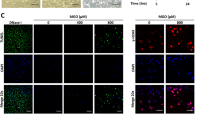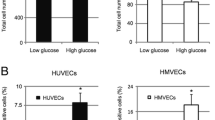Abstract
Diabetic hyperglycaemia causes endothelial dysfunction mainly by impairing endothelial nitric oxide (NO) production. Moreover, hyperglycaemia activates several noxious cellular pathways including apoptosis, increase in reactive oxygen species (ROS) levels and diminishing Na+–K+ ATPase activity which exacerbate vascular damage. Serum glucocorticoid kinase (SGK)-1, a member of the serine/threonine kinases, plays a pivotal role in regulating NO production through inducible NO synthase activation and other cellular mechanisms. Therefore, in this study, we aimed to investigate the protective role of SGK-1 against hyperglycaemia in human umbilical endothelial cells (HUVECs). We used retrovirus to infect HUVECs with either SGK-1, SGK-1Δ60 (lacking of the N-60 amino acids—increase SGK-1 activity) or SGK-1Δ60KD (kinase-dead constructs). We tested our hypothesis in vitro after high glucose and glucosamine incubation. Increase in SGK-1 expression and activity (SGK-1Δ60) resulted in higher production of NO, inhibition of ROS synthesis and lower apoptosis in endothelial cell after either hyperglycaemia or glucosamine treatments. Moreover, in this study, we showed increased GLUT-1 membrane translocation and Na+−K+ ATPase activity in cell infected with SGK-1Δ60 construct. These results suggest that as in endothelial cells, an increased SGK-1 activity and expression reduces oxidative stress, improves cell survival and restores insulin-mediated NO production after different noxae stimuli. Therefore, SGK-1 may represent a specific target to further develop novel therapeutic options against diabetic vascular disease.






Similar content being viewed by others
References
Verma S, Buchanan MR, Anderson TJ (2003) Endothelial function testing as a biomarker of vascular disease. Circulation 108:2054–2059
Griendling KK, FitzGerald GA (2003) Oxidative stress and cardiovascular injury: part I: basic mechanisms and in vivo monitoring of ROS. Circulation 108:1912–1916
Bakker W, Eringa EC, Sipkema P, van Hinsbergh VW (2009) Endothelial dysfunction and diabetes: roles of hyperglycemia, impaired insulin signaling and obesity. Cell Tissue Res 335:165–189
Lang F, Artunc F, Vallon V (2009) The physiological impact of the serum and glucocorticoid-inducible kinase SGK1. Curr Opin Nephrol Hypertens 18:439–448
Engelsberg A, Kobelt F, Kuhl D (2006) The N-terminus of the serum- and glucocorticoid-inducible kinase Sgk1 specifies mitochondrial localization and rapid turnover. Biochem J 399:69–76
Waldegger S, Barth P, Raber G, Lang F (1997) Cloning and characterization of a putative human serine/threonine protein kinase transcriptionally modified during anisotonic and isotonic alterations of cell volume. Proc Natl Acad Sci USA 94:4440–4445
Failor KL, Desyatnikov Y, Finger LA, Firestone GL (2007) Glucocorticoid-induced degradation of glycogen synthase kinase-3 protein is triggered by serum- and glucocorticoid-induced protein kinase and Akt signaling and controls beta-catenin dynamics and tight junction formation in mammary epithelial tumor cells. Mol Endocrinol 21:2403–2415
Garcia-Martinez JM, Alessi DR (2008) mTOR complex 2 (mTORC2) controls hydrophobic motif phosphorylation and activation of serum- and glucocorticoid- induced protein kinase 1 (SGK1). Biochem J 416:375–385
Helms MN, Yu L, Malik B, Kleinhenz DJ, Hart CM, Eaton DC (2005) Role of SGK1 in nitric oxide inhibition of ENaC in Na+-transporting epithelia. Am J Physiol Cell Physiol 289(3):C717–C726
Tessier M, Woodgett JR (2006) Serum and glucocorticoid-regulated protein kinases: variations on a theme. J Cell Biochem 98:1391–1407
Boini KM, Hennige AM, Huang DY, Friedrich B, Palmada M, Boehmer C, Grahammer F, Artunc F, Ullrich S, Avram D, Osswald H, Wulff P, Kuhl D, Vallon V, Haring HU, Lang F (2006) Serum- and glucocorticoid-inducible kinase 1 mediates salt sensitivity of glucose tolerance. Diabetes 55:2059–2066
Turpaev K, Bouton C, Diet A, Glatigny A, Drapier JC (2005) Analysis of differentially expressed genes in nitric oxide-exposed human monocytic cells. Free Radic Biol Med 38(10):1392–1400
Duan W, Paka L, Pillarisetti S (2005) Distinct effects of glucose and glucosamine on vascular endothelial and smooth muscle cells: evidence for a protective role for glucosamine in atherosclerosis. Cardiovasc Diabetol 5(4):16
Rl Post, Ak Sen, As Rosenthal (1965) A phosphorylated intermediate in adenosine triphosphate-dependent sodium and potassium transport across kidney membranes. J Biol Chem 240:1437–1445
Handa O, Stephen J, Cepinskas G (2008) Role of endothelial nitric oxide synthase-derived nitric oxide in activation and dysfunction of cerebrovascular endothelial cells during early onsets of sepsis. Am J Physiol Heart Circ Physiol 295(4):H1712–H1719. doi:10.1152/ajpheart.00476.2008
Mikosz CA, Brickley DR, Sharkey MS, Moran TW, Conzen SD (2001) Glucocorticoid receptor-mediated protection from apoptosis is associated with induction of the serine/threonine survival kinase gene, SGK-1. J Biol Chem 276(20):16649–16654
Palmada M, Boehmer C, Akel A, Rajamanickam J, Jeyaraj S, Keller K, Lang F (2006) SGK1 kinase upregulates GLUT1 activity and plasma membrane expression. Diabetes 55:421–427
Alvarez de la Rosa D, Coric T, Todorovic N, Shao D, Wang T, Canessa CM (2003) Distribution and regulation of expression of serum- and glucocorticoid-induced kinase-1 in the rat kidney. J Physiol 551(Pt 2):455–466
Brownlee M (2005) The pathobiology of diabetic complications: a unifying mechanism. Diabetes 54:1615–1625
Feng Y, Wang Y, Xiong J, Liu Z, Yard B, Lang F (2006) Enhanced expression of serum and glucocorticoid-inducible kinase-1 in kidneys of L-NAME-treated rats. Kidney Blood Press Res 29(2):94–99
Li H, Horke S, Förstermann U (2013) Oxidative stress in vascular disease and its pharmacological prevention. Trends Pharmacol Sci 34(6):313–319. doi:10.1016/j.tips.2013.03.007
Schoenebeck B, Bader V, Zhu XR, Schmitz B, Lübbert H, Stichel CC (2005) SGK1, a cell survival response in neurodegenerative diseases. Mol Cell Neurosci 30(2):249–264
Brunet A, Park J, Tran H, Hu LS, Hemmings BA, Greenberg ME (2001) Protein kinase SGK mediates survival signals by phosphorylating the forkhead transcription factor FKHRL1 (FOXO3a). Mol Cell Biol 21(3):952–965
Dehner M, Hadjihannas M, Weiske J, Huber O, Behrens J (2008) Wnt signaling inhibits forkhead box O3a-induced transcription and apoptosis through up-regulation of serum- and glucocorticoid-inducible kinase 1. J Biol Chem 283(28):19201–19210
Kemeny SF, Figueroa DS, Clyne AM (2013) Hypo- and hyperglycemia impair endothelial cell actin alignment and nitric oxide synthase activation in response to shear stress. PLoS ONE 8(6):e66176. doi:10.1371/journal.pone.0066176
Kliche K, Jeggle P, Pavenstädt H, Oberleithner H (2011) Role of cellular mechanics in the function and life span of vascular endothelium. Pflugers Arch 462(2):209–217. doi:10.1007/s00424-011-0929-2
Bełtowski J, Rachańczyk J, Włodarczyk M (2013) Thiazolidinedione-induced fluid retention: recent insights into the molecular mechanisms. PPAR Res 2013:628628. doi:10.1155/2013/628628
Schwab M, Lupescu A, Mota M, Mota E, Frey A, Simon P, Mertens PR, Floege J, Luft F, Asante-Poku S, Schaeffeler E, Lang F (2008) Association of SGK1 gene polymorphisms with type 2 diabetes. Cell Physiol Biochem 21(1–3):151–160. doi:10.1159/000113757
Rao AD, Sun B, Saxena A, Hopkins PN, Jeunemaitre X, Brown NJ, Adler GK, Williams JS (2013) Polymorphisms in the serum- and glucocorticoid-inducible kinase 1 gene are associated with blood pressure and renin response to dietary salt intake. J Hum Hypertens 27(3):176–180. doi:10.1038/jhh.2012.22
Acknowledgments
We thank Dr Suzanne Conzen, Department of Medicine section of Haematology/Oncology, University of Chicago, USA. This work has been supported by the following grants: the Italian Ministry of Health–IRCSS Monzino RF2007; Research Project 2009, Fondazione Roma, Italy; 2008 and 2010–2011 PRIN, Italian Department of Research and University; Fondazione Umberto Di Mario, Rome.
Conflict of interest
Francesca Ferrelli, Donatella Pastore, Barbara Capuani, Marco F Lombardo, Marcel Blot-Chabaud, Andrea Coppola, Katia Basello, Angelica Galli, Giulia Donadel, Maria Romano, Sara Caratelli, Francesca Pacifici, Roberto Arriga, Nicola Di Daniele, Paolo Sbraccia, Giuseppe Sconocchia, Alfonso Bellia, Manfredi Tesauro, Massimo Federici, David Della-Morte, Davide Lauro declare that they have no conflict of interest.
Ethical standard
All procedures performed in studies involving human participants were in accordance with the ethical standards of the institutional and/or national research committee and with the 1964 Helsinki declaration and its later amendments or comparable ethical standards.
Human and animal rights
This article does not contain any studies with human or animal subjects performed by the any of the authors.
Informed consent
The informed consent disclosure statements is not applicable for this study since the human cells used were purchased from a biocompany.
Author information
Authors and Affiliations
Corresponding author
Additional information
Managed by Antonio Secchi.
Electronic supplementary material
Below is the link to the electronic supplementary material.
592_2014_600_MOESM1_ESM.tif
Fig. S1. L-NAME inhibits SGK-1-mediated increase in NO production. NO production assayed in basal state (a) and after glucose (25mM glucose, HG), (b) or glucosamine (10mM Gluc-N ) () (c) treatments for 72 hours with insulin stimulation 10-7 M (1 hour) and with L-NAME (100 μM) 30 minutes before insulin. Supplementary material 1 (TIFF 765 kb)
592_2014_600_MOESM2_ESM.tif
Fig. S2. Mannitol treatment of infected HUVEC. Infected HUVEC were treated with mannitol 20 mM for 72 hours as osmotic control. After treatments with glucose and glucosamine, NO production (a), ROS (b) and apoptosis (c) were measured using cytofluorimetric analysis. No differences were observed among different infected cell groups. Supplementary material 2 (TIFF 673 kb)
592_2014_600_MOESM3_ESM.tif
Fig. S3. SGK-1 reduces apoptosis through Fox3a inhibition. Sub-cellular localization of FoxO3a in cytoplasm and membrane fraction, before and after insulin stimulation (10-7 M, 30 minutes after 16–18 hours of serum starvation) and/or GSK650394 treatments. In basal condition, FoxO3a distribution was predominantly cytoplasmatic in pLPCX (a), SGK-1wt (e) and SGK-1Δ60 (i) infected HUVECs cells, whereas it was predominantly nuclear in SGK-1Δ60KD (o). SGK-1 inhibitor GSK650394 induced a significant decrease of FoxO3a in the cytoplasm of SGK-1wt (g) while did not affect the FoxO3a cytoplasm levels of SGK-1Δ60 (m)-infected cells. Similar effect was present after insulin stimulus (f, l). In cells infected with SGK-1Δ60KD, FoxO3a distributions were mainly nuclear also after insulin and/or inhibitor treatments (p, r). Supplementary material 3 (TIFF 641 kb)
592_2014_600_MOESM4_ESM.tif
Fig. S4. Schematic diagram of mechanisms of endothelial cells protection mediated by overactivation of SGK1 (SGK-1Δ60). Infected HUVECs by SGK-1Δ60 respond to hyperglycaemic and insulin stimuli by the following: 1. increasing NO production and eNOS phosphorylation; 2. reducing ROS levels, 3. decreasing apoptosis, 4. increasing of FOXOa3 phosphorylation and its translocation in the cytoplasm, 5. enhancing GLUT-1 translocation; and 6. increasing in Na+-K+ ATPase activity. Supplementary material 4 (TIFF 685 kb)
Rights and permissions
About this article
Cite this article
Ferrelli, F., Pastore, D., Capuani, B. et al. Serum glucocorticoid inducible kinase (SGK)-1 protects endothelial cells against oxidative stress and apoptosis induced by hyperglycaemia. Acta Diabetol 52, 55–64 (2015). https://doi.org/10.1007/s00592-014-0600-4
Received:
Accepted:
Published:
Issue Date:
DOI: https://doi.org/10.1007/s00592-014-0600-4




